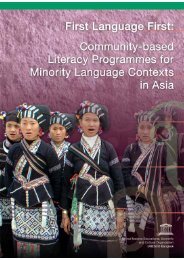Part II.pdf - MTB-MLE Network
Part II.pdf - MTB-MLE Network
Part II.pdf - MTB-MLE Network
You also want an ePaper? Increase the reach of your titles
YUMPU automatically turns print PDFs into web optimized ePapers that Google loves.
presentation of the materials. This process facilitated the identification of materials that can be<br />
developed/adapted/modified to suit the needs and reflect the real situation of the Magbikin tribe.<br />
A.7 Preparation of the Basic Learning Materials<br />
Initial Development: Before the writers and translators started developing sample basic literacy<br />
learning materials, a resource person on curriculum and literacy materials development provided<br />
input on the rudiments of curriculum and materials development.<br />
The writers used the writing briefs in identifying the format of the learning materials and competencies<br />
to be developed. They also agreed on the number of learning materials to be developed based on<br />
the writing brief in consultation with the Magbikin representatives. The following is the agreed<br />
format of the materials to be developed: posters (folded poster and accordion poster), modules<br />
and primers/booklets.<br />
Initially, one sample basic literacy material was developed during the workshop. In order to see<br />
whether the writers were on the right track, the draft of the sample literacy materials underwent<br />
a rigid peer and group critiquing by the participants. Additional guidelines on learning materials<br />
development were given as they went through the review. Feedback generated during the critiquing<br />
process served as a basis for revision of the learning materials.<br />
On-site Preparation of the Basic Literacy Materials: The Research Team decided to continue<br />
the learning materials preparation in a place closer to the actual site. This gave the writers, illustrator,<br />
layout artist and all others involved in the learning<br />
materials development process the chance to have<br />
an actual visit to the Magbikin community to see<br />
for themselves what the Magbikin people and their<br />
community look like, how their houses are built, and<br />
their environment.<br />
This process also ensures that the learning materials<br />
being developed will truly reflect the physical<br />
features of the Magbikin people, their surroundings,<br />
the houses and other unique characteristics of their<br />
community. This is being done to make the learning<br />
materials close to the people’s hearts.<br />
A.8 Validation of Learning Materials<br />
The main objectives of the validation process are to<br />
try out the new indigenized learning materials with tribe members and to document respondents’<br />
corrections, suggestions and recommendations in order to improve the materials. A total of twenty<br />
respondents participated in the validation of the learning materials.<br />
The respondents were grouped into four groups with five members in each group. The members<br />
of the Action Research Team composed of BNFE staff and NFE field implementers served as<br />
facilitators of the whole process of validation. Because the respondents were zero literate, the<br />
191
















